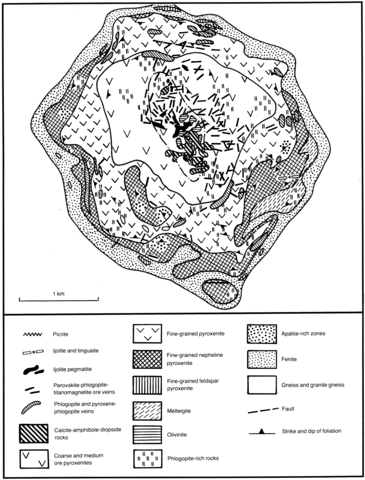stripes
This complex has an isometric shape, an area of some 7 km2, and lies on an east-west-trending fracture system. The country rocks are granite gneisses. Four zones can be distinguished from the periphery to the centre. The outermost zone, with a width of 500 m, contains nepheline- and feldspar-bearing pyroxenites which grade into melteigites. The rocks in this zone have a layered structure and comprise nepheline, aegirine-augite and microcline with lesser amounts of melanite, amphibole, biotite, cancrinite, apatite, titanite, titanomagnetite, perovskite, sodalite, calcite and sulphides. The second zone includes fine-grained nepheline-bearing pyroxenites, enriched in apatite, mica and amphibole. The fine-grained pyroxenites are gradually replaced by medium- and coarse-grained nepheline pyroxenites towards the centre of the massif and these constitute the third zone. Some pyroxenites are of exceptionally coarse grain size and these are enriched in titanomagnetite. The main minerals of these pyroxenites are diopside-augite, olivine and titanomagnetite with subordinate serpentine, phlogopite, pargasite, titanite, chlorite and calcite. The rocks of the third zone are cut by phlogopite-pyroxene rocks. The fourth zone, occupying the central part of the complex, has the most complicated structure and comprises coarse-grained pyroxenites, olivinites, sometimes containing melilite, calcite-amphibole-pyroxene rocks with nests of perovskite, and alkaline pegmatites, of a range of compositions, which cut the olivinites and pyroxenites extensively. The mineralogy of the olivinites is olivine (12-14% Fa), magnetite and perovskite with lesser diopside, augite, phlogopite, melilite and monticellite. The calcite-amphibole-pyroxene rocks, as well as these minerals, also include perovskite, titanite, phlogopite, actinolite, apatite, nepheline, zirconolite and pyrochlore. Other veins include ilmenite-titanomagnetite-rich rocks, ijolite pegmatites with schorlomite, calcite carbonatites and calcite-zeolite veins with prehnite.
GORBUNOV, G.I., BEL'KOV, I.V., MAKIEVSKY, S.I., GORYAINOV, P.M., SAKHAROV, A.S., YUDIN, B.A., ONOKHIN, F.M., GONCHAROV, Yu.V., ANTONYUK, E.S. and VESELOVSKY, N.N. 1981. Mineral deposits of the Kola Peninsula. Nauka, Leningrad. 272 pp.
GORKOVETZ, B.Ya., RAYEVSKAYA, M.B, BELOUSOV, E. and IRINA, K.A.. 1981. Geology and metallogeny of the Kostomuksha ore deposit region. 107-9. Petrozavodsk, Karelia. 143 pp.
*KRAMM, U., KOGARKO, L.N., KONONOVA, V.A. and VARTIAINEN, H. 1993. The Kola alkaline province of the CIS and Finland: precise Rb-Sr ages define 380-360 Ma age range for all magmatism. Lithos, 30: 33-44.
KUKHARENKO, A.A., ORLOVA, M.P., BULAKH, A.G., BAGDASAROV, E.A., RIMSKAYA-KORSAKOVA, O.M., NEPHEDOV, E.I., IL'INSKII, G.A., SERGEEV, A.S. and ABAKUMOVA, N.B. 1965. The Caledonian complex of ultrabasic alkaline rocks and carbonatites of the Kola peninsula and north Karelia. Nedra, Moscow. 772 pp.

